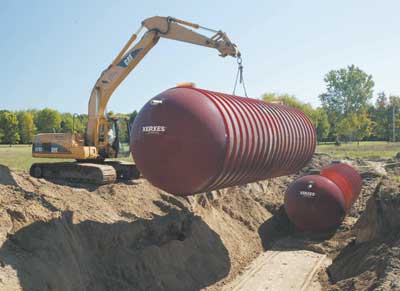The availability of space is a paramount factor which will determine the placement of your rainwater tank, and the ground raindrops tanks occupy additional space than those fitted below ground. These underground water storage containers save space as well as don’t get in your way. Weather conditions changes is not an immense problem for underground tanks. An underground tank system can usually be built to hold any amount of water necessary. The subsurface position of the container frees up space for reforming or a driveway whereas ensuring optimum conditions for retaining water. Water management in any soils is possible.
Problems That One Can Face With Underground Rainwater Storage Tanks
There are some disadvantages to having a tank built underground. Firstly, you need a pump to extract the water, which is not the case for above ground tanks, as gravity does all the work for you. Second, any leaks and malfunctions are difficult to detect; this becomes much easier when you can clearly see every part of the above ground tank. Next, tree roots can hamper the structure of underground water storage tanks and can pollute the water that you must have covered for your underground tank to avoid soil, feces, and pesticides inflowing the water during rains. Overhead ground tanks need not essentially be covered, even though some are covered as an additional precaution. Maintenance of the overhead ground tanks is as well a little easier.

Problems That One Can Face With Open Rainwater Storage Tanks
On the other hand, a lot of the issues that one faces with above ground tanks are not appropriate to underground tanks. Pouring rains, the wind, and fire as well as extremes of hot and cold do not harm tanks built underground. Many people choose to have their tanks installed above ground, just because it is a simpler operation and takes less time. But underground pools are ideal for individuals who have significant water needs, such as a swimming pool to fill. Maybe they have a large area under a deck which would be perfect for a rainwater tank. Other options are underneath driveways, pergolas or under sheds. A below ground tank is usually constructed of concrete but can also be made of poly plastic.
Having the Tank Above As Well As Below the Ground
One interesting combination is to have your tank both above and below the ground. That is, the tank is partly submerged, often placed along a fence line, so that a larger tank can be installed, without marring the aesthetic appearance of the home. Rainwater tanks should be installed by a qualified and experienced plumber. If space is at a premium, underground tanks make an excellent choice. Rainwater harvesting system elements are made of long lasting materials resistant to rusting and chemical contamination and have a simple technical structure. This makes maintenance and cleaning a very simple procedure.
Final Words
On the whole, installing underground rainwater storage tank does make sense because by installing underground rainwater storage tanks, you will be more than halving your water bills and also conserving this precious resource. Only 1% of daily water consumption is used for drinking and a further small percentage for personal hygiene and cooking. So a lot of the water consumed does not need to be of high quality. This is why installing a rainwater tank makes perfect sense. It can be used for gardening, car washing, and toilet flushing and general household cleaning. It makes financial sense and is ideal for conserving resources.







